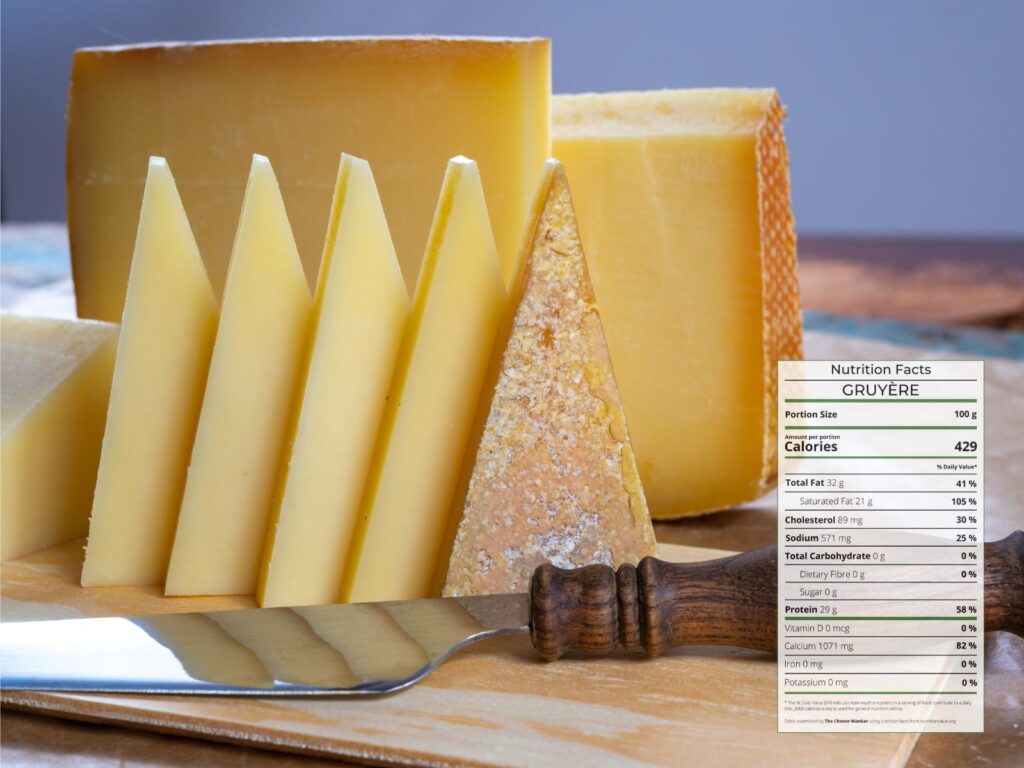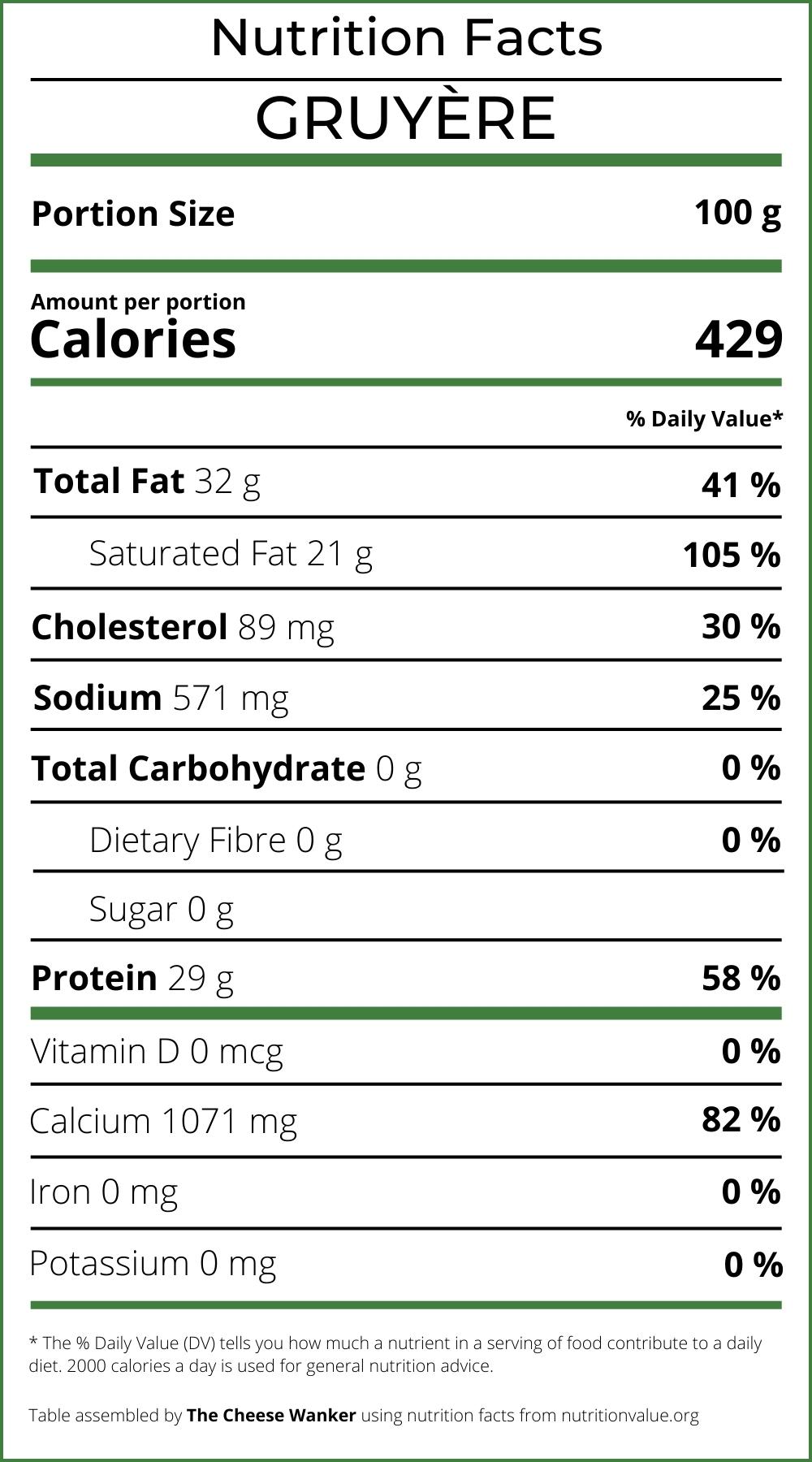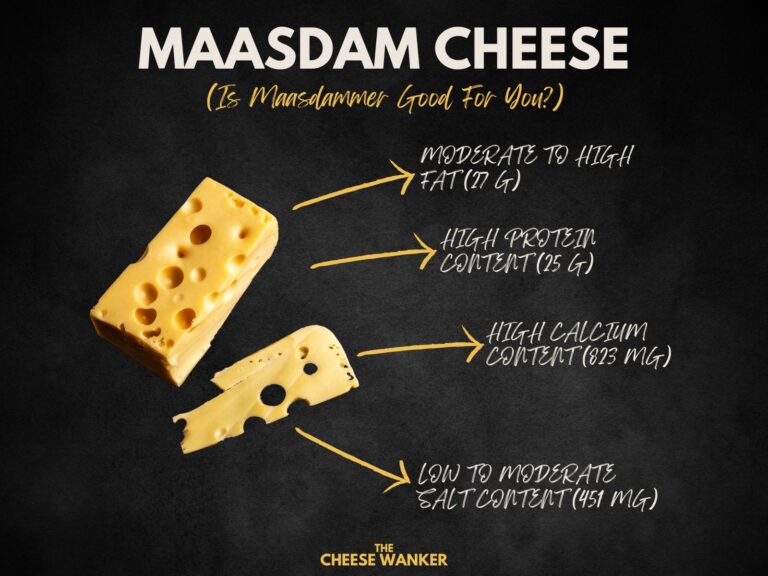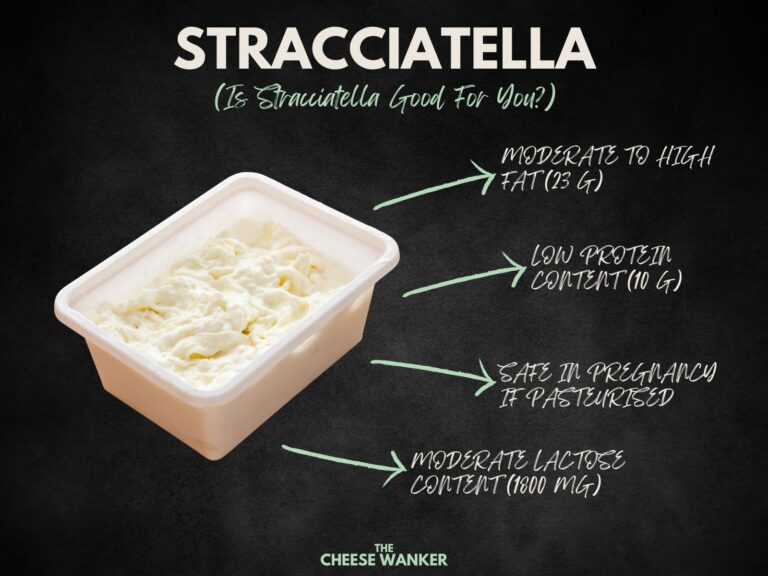Gruyère cheese is a well-known and beloved Swiss cheese that has gained popularity around the world for its distinctive nutty flavour and smooth texture. In this blog post, we delve into the nutrition facts for Gruyère cheese, examining its composition and highlighting important aspects such as lactose intolerance, fat content, protein content and safety in pregnancy.

SEE ALSO: Nutrition facts for popular world cheeses in The Cheese Wanker’s index →
What is Gruyère?
Gruyère cheese is a pressed cooked cheese made from cow’s milk, originating in the Gruyère region of Switzerland. It is characterised by its pale-yellow paste and a unique flavour profile that combines notes of sweetness and nuttiness.
The cheese undergoes a meticulous ageing process, typically lasting between 5 and 12 months, which contributes to its distinct taste and texture.
You can read more about the history of Switzerland’s most loved cheese in our dedicated post here.
Nutrition fact sheet

Nutritional review for Gruyère
Eating healthy plays a pivotal role in maintaining overall well-being and preventing chronic diseases. A balanced and nutritious diet provides our bodies with essential vitamins, minerals, and macronutrients, fuelling optimal physical and cognitive function.
With this in mind, let’s have a look at some of the key nutrition facts for Gruyère cheese.
Lactose Intolerance
For individuals with lactose intolerance, consuming dairy products can often pose challenges. However, Gruyère cheese is generally well-tolerated due to its low lactose content.
The cheesemaking process involves the fermentation of lactose by lactic acid bacteria, which reduces the lactose content significantly. As a result, Gruyère cheese can be enjoyed by many individuals who experience lactose intolerance symptoms when consuming other dairy products.
Fat Content
Gruyère cheese is a source of dietary fat, an essential macronutrient that plays various roles in our bodies. It contains approximately 32 grams of fat per 100 grams. While the fat content may appear relatively high, it is worth noting that Gruyère cheese offers a good balance of saturated and unsaturated fats.
Consuming cheese in moderation can contribute to a well-rounded diet and provide necessary fat-soluble vitamins. Moreover, thanks to its very low carbohydrate content, Gruyère is a great choice for cheese lovers on a ketogenic diet.
You can learn more about the different types of fat in cheese and which cheeses have the lowest fat content here.
Cholesterol Content
Contrary to popular belief, dietary cholesterol has a minimal impact on blood cholesterol levels for most individuals. Gruyère cheese contains around 90 milligrams of cholesterol per 100 grams, which can be considered a moderate amount.
It is essential to maintain a balanced diet and focus on overall healthy eating patterns rather than solely monitoring cholesterol intake from individual food sources.
Protein Content
Proteins are the building blocks of our bodies, supporting tissue growth, repair and various physiological functions. Gruyère cheese is a valuable source of protein, providing approximately 29 grams per 100 grams.
The protein in Gruyère cheese is considered high-quality, containing essential amino acids necessary for optimal health. Including Gruyère cheese as part of a balanced diet can contribute to meeting daily protein requirements.
Want to find out which cheeses have the highest protein content? Click here for our blog post covering cheeses with the highest protein content.
Safety in Pregnancy
Pregnancy demands additional attention to nutrient intake and food safety. Even though it is made with raw milk, Gruyère is generally considered safe to consume during pregnancy.
Indeed, FSANZ consider aged raw milk cheeses like Gruyère, Parmigiano Reggiano and Comté to have a similar safety profile to pasteurised cheeses. The reason behind this stance is the low moisture and high salt content. Those contribute to an environment that is not hospitable to pathogens like Listeria monocytogenes.
You can read more about which cheeses you can eat when you’re pregnant by clicking here. As always, if unsure, you should consult your doctor.
Salt Content
Sodium is an essential mineral required for various bodily functions, but excessive consumption can be detrimental to health. Gruyère cheese contains approximately 500-600 milligrams of sodium per 100 grams, which is considered moderate.
While the salt content in Gruyère cheese is not excessive, it is important to be mindful of overall sodium intake and balance it with other low-sodium food choices.
Calcium Content
Calcium is crucial for maintaining healthy bones and teeth, nerve transmission and muscle function. Gruyère cheese offers a good source of dietary calcium, providing around 1000-1100 milligrams per 100 grams.
Including Gruyère cheese as part of a balanced diet can help meet calcium requirements, particularly for individuals who may have dietary restrictions limiting other calcium-rich foods.
Conclusion
In conclusion, Gruyère cheese is a flavourful Swiss cheese with a rich nutritional profile. It is relatively low in lactose, making it a suitable option for individuals with lactose intolerance.
While it contains a moderate amount of fat and cholesterol, the overall balance of fats in Gruyère cheese makes it a valuable addition to a well-rounded diet.
Additionally, Gruyère cheese is a significant source of high-quality protein and dietary calcium. As with any food, moderation is key, and incorporating Gruyère cheese into a diverse and balanced eating pattern can provide both taste and nutrition.
What’s your favourite way to enjoy this iconic Swiss cheese? Let us know in the comments below.
References
Overall nutritional content
The nutritional content of cheese in our table comes from the USDA Food Data Central Repository, the Australian Food Composition Database and cheese manufacturers. We realise that there can be variations between different brands and producers. Hence, the numbers we have used are averages.
Fat content
Our fat RDI data comes from Cleveland Clinic’s Healthy Fat Intake resource.
Type of fat in cheese as per Harvard T.H. Chan’s The Nutrition Source.
Protein content
Our protein RDI data comes from Harvard Medical School’s Harvard Health Publishing.
Cholesterol content
Is There a Correlation between Dietary and Blood Cholesterol? Evidence from Epidemiological Data and Clinical Interventions? – Maria Luz Fernandez and Ana Gabriela Murillo
Saturated fat, carbohydrate, and cardiovascular disease – Patty W Siri-Tarino, Qi Sun, Frank B Hu and Ronald M Krauss
Effect of cheese consumption on blood lipids: a systematic review and meta-analysis of randomized controlled trials – Janette de Goede, Johanna M Geleijnse, Eric L Ding, Sabita S Soedamah-Muthu
Safety in pregnancy
All the advice relating to what cheeses you can eat during pregnancy in this article is based on the recommendations by health authorities in Australia, the UK and the USA. If you are unsure about what you can or cannot eat, please consult your doctor.
Australia – FSANZ, United Kingdom – NHS and United Sates of America – FDA
Lactose content
Lactose residual content in PDO cheeses
Detection of lactose in products with low lactose content
The analysis of lactose in milk and cheese products by HPLC
Food Standards ANZ Food Composition Database
Lactose & Galactose content of cheese



